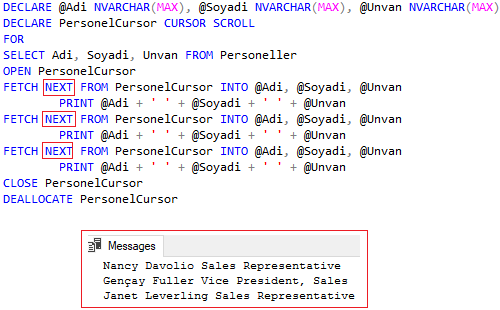
Row operations can take a long time to execute depending upon the type of task being performed on each row. While a cursor is being populated, the table being iterated is locked. The principal factor problem affecting cursor speed is the number of rows and columns brought into it. The problem with the cursor is that, in most cases, we can use JOINS, even WHILE clauses, SSIS packages, or other alternative methods to get the same result quicker, with less impact on performance output and even writing fewer lines of syntax.
#Ms sql cursors full#
They’re used for quick programming when a developer does not have a full understanding of set operations. What are the cursors’ limitations?Ĭursors are used frequently as the wrong tool for the wrong task. The example below renames all tables in the sample database named as Spreadsheet, by adding ‘_Backup’ to each table’s name while also ensuring that tables containing ‘_Backup’ in their name will not be renamed again by running the following code: Figure 3 – SQL Server Cursor sample. If another user deletes a record, it is inaccessible from our recordset. This is like a dynamic cursor except we can’t see records others add.
#Ms sql cursors update#
You can use this cursor to perform INSERT, DELETE, and UPDATE operations. Unlike static cursors, all the changes made in the Dynamic cursor will reflect the Original data. It is identical to the static except that you can only scroll forward.Īdditions and deletions are visible for others in the data source while the cursor is open. A static cursor can move forward and backward. Populates the result set during cursor creation and the query result is cached for the lifetime of the cursor. Microsoft SQL Server supports the following types of cursors. What are the different types of a cursor in SQL Server?

#Ms sql cursors how to#
How to Create a SQL Server Cursor? Figure 1 – The Life Cycle of SQL Server cursor.

The idea behind cursors sounds perfect and writing one seems good, but one can runs into big problems when it comes to performance. A cursor is a similar approach to any looping mechanism found in any other programming. There are some conditions when we want to get a record from one table and need to insert it into another with performing some condition or logic. A SQL cursor is a database object which is used to manipulate data in a set, do row-by-row processing, instead of the T-SQL commands that operate on all the rows in the result set at one time.


 0 kommentar(er)
0 kommentar(er)
